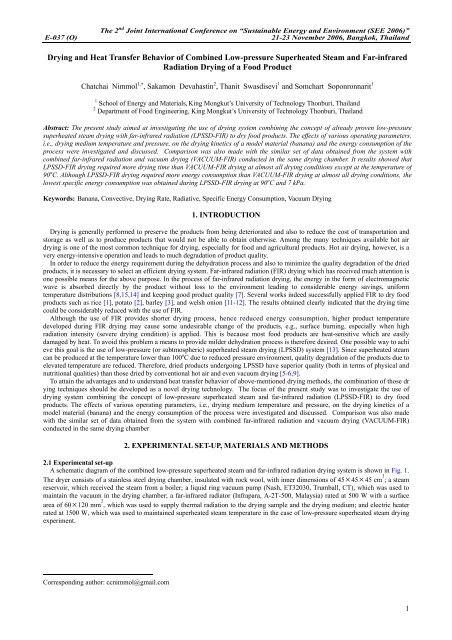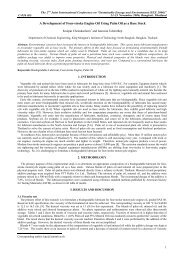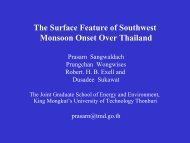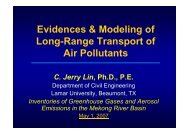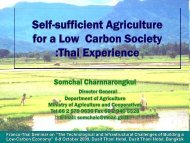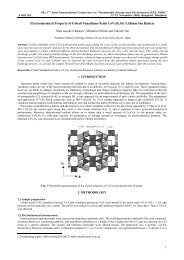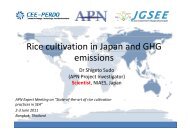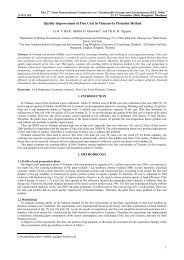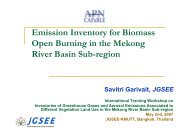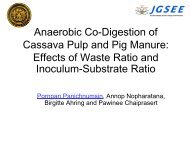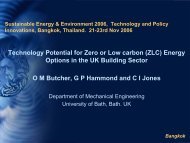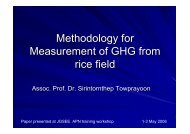Drying and Heat Transfer Behavior of Combined Low ... - JGSEE
Drying and Heat Transfer Behavior of Combined Low ... - JGSEE
Drying and Heat Transfer Behavior of Combined Low ... - JGSEE
- No tags were found...
Create successful ePaper yourself
Turn your PDF publications into a flip-book with our unique Google optimized e-Paper software.
The 2 nd Joint International Conference on “Sustainable Energy <strong>and</strong> Environment (SEE 2006)”E-037 (O) 21-23 November 2006, Bangkok, Thail<strong>and</strong>Fig. 3 Changes in moisture content <strong>and</strong> temperature <strong>of</strong> banana slices undergoing LPSSD-FIR at different drying conditions.moisture ratio; drying medium temperature; sample temperatureFig. 4 Changes in moisture content <strong>and</strong> temperature <strong>of</strong> banana slices undergoing VACUUM-FIR at different drying conditions.moisture ratio; drying medium temperature; sample temperature4
The 2 nd Joint International Conference on “Sustainable Energy <strong>and</strong> Environment (SEE 2006)”E-037 (O) 21-23 November 2006, Bangkok, Thail<strong>and</strong>In the case <strong>of</strong> VACUUM-FIR drying it was found from Fig. 4 that the temperature <strong>of</strong> the samples also suddenly dropped duringthe initial period <strong>of</strong> the process. However, the temperature <strong>of</strong> the samples after this period steadily rose to the level higher than thepre-determined medium temperature, as noted earlier in the case <strong>of</strong> LPSSD-FIR drying, without the period <strong>of</strong> constant sampletemperature. After this period the temperature <strong>of</strong> the samples also remained almost constant as in the case <strong>of</strong> LPSSD-FIR drying.To investigate the effects <strong>of</strong> radiation intensity <strong>of</strong> far-infrared radiator on the temperature evolution <strong>of</strong> the sample, the temperature<strong>of</strong> samples dried by LPSSD-FIR <strong>and</strong> VACUUM-FIR were again compared. At the same drying conditions, it can be seen from Figs. 3<strong>and</strong> 4 that the sample temperature during the later stage <strong>of</strong> the process in the case <strong>of</strong> LPSSD-FIR drying was higher than in the case<strong>of</strong> VACUUM-FIR drying. This is due to the fact that in the case <strong>of</strong> LPSSD-FIR drying, radiation intensity at the position <strong>of</strong> thethermocouple used for sending the signal to the PID controller (at 30 mm above the sample surface) was more attenuated due to theabsorption <strong>of</strong> superheated steam, resulting from higher far-infrared radiation absorptivity <strong>of</strong> superheated steam due to the presence <strong>of</strong>a large proportion <strong>of</strong> water vapor [10]. Therefore, the far-infrared radiator during LPSSD-FIR drying was used more <strong>of</strong>ten tomaintain the desired level <strong>of</strong> drying medium temperature leading to higher surface temperature <strong>of</strong> the far-infrared radiator (data is notshown). Consequently, the radiation intensity, depending on the surface temperature <strong>of</strong> the far-infrared radiator, experienced byLPSSD-FIR sample was greater hence higher level <strong>of</strong> the sample temperature. It was also observed that in the case <strong>of</strong> VACUUM-FIRdrying at 70 o C (see Figs. 4e <strong>and</strong> 4f) the sample temperature during the later stage <strong>of</strong> the process was very close to the drying mediumtemperature (not much higher than the drying medium temperature) compared with those dried at higher temperatures. This mayprobably due to the fact that when drying at lower temperature (70 o C in this case), the radiation intensity was lower indicated bylower surface temperature <strong>of</strong> the far-infrared radiator. Since the sample temperature was not controlled by the drying mediumtemperature but by the radiation intensity, very high sample temperatures developed in the cases <strong>of</strong> drying at higher temperaturesresulting in overheating <strong>and</strong> burning <strong>of</strong> the product hence degradation <strong>of</strong> dried product quality, especially in the case <strong>of</strong> LPSSD-FIRdrying at the highest temperature tested (90 o C). It should be noted that the effects <strong>of</strong> drying pressure on the level <strong>of</strong> sampletemperature during the later state <strong>of</strong> drying mentioned earlier was not significant.3.3 Energy consumptionTable 1 compares energy consumption along with drying time <strong>of</strong> banana slices undergoing different drying methods <strong>and</strong> conditions.It can be seen from this table that the energy consumption <strong>of</strong> the vacuum pump increased with an increase in the drying time. This isbecause electrical energy consumed by the vacuum pump at all drying conditions were the same, 1.5 kWh in this study. Regardingthe electrical energy required to generate thermal energy, it was found that the electrical energy required to generate thermal energy<strong>of</strong> LPSSD-FIR drying was higher than that <strong>of</strong> VACUUM-FIR at all drying conditions. This is because the far-infrared radiator wasused more <strong>of</strong>ten during LPSSD-FIR drying resulting from higher far-infrared radiation absorptivity <strong>of</strong> superheated steam asmentioned earlier in the case <strong>of</strong> temperature evolution.<strong>Drying</strong>methodLPSSD-FIRVACUUM-FIRTemp( o C)708090708090Table 1 Energy consumption at different drying methods <strong>and</strong> conditionsPressureEnergy consumption (kWh) Specific Total steam<strong>Drying</strong> timeenergy consumption Consumption(kPa) (min) Vacuum pump b Thermal Total (kWh/kg water) (kg)10 N/A a N/A N/A N/A N/A N/A7 N/A N/A N/A N/A N/A N/A10 190 4.750 0.530 5.280 193.975 82.3337 140 3.500 0.490 3.990 146.583 60.66710 100 2.500 0.420 2.920 107.274 43.3337 90 2.250 0.410 2.660 97.722 39.00010 255 6.375 0.230 6.605 242.652 –7 185 4.625 0.200 4.825 177.259 –10 145 3.625 0.270 3.895 143.093 –7 130 3.250 0.250 3.500 128.582 –10 120 3.000 0.340 3.340 122.704 –7 110 2.750 0.330 3.080 113.152 –a N/A implies that the final moisture content <strong>of</strong> 3.5% (d.b.) was not obtainable at this condition.b The electrical energy consumption required to operate the vacuum pump was 1.5 kWh.c The flow rate <strong>of</strong> steam into the drying chamber was maintained at about 26 kg/h.Considering the total energy consumption that is the sum <strong>of</strong> the electrical energy required to operate the vacuum pump <strong>and</strong> togenerate thermal energy, it was found that although, at the same drying condition, the electrical energy required to generate thermalenergy <strong>of</strong> LPSSD-FIR drying was higher than that <strong>of</strong> VACUUM-FIR drying, the total energy consumption <strong>of</strong> LPSSD-FIR drying waslower when drying was performed at the temperature <strong>of</strong> 90 o C. This is due to the fact that this level <strong>of</strong> drying temperature (90 o C) wasabove the inversion temperature, which was somewhere between 80 o <strong>and</strong> 90 o C as noted earlier, resulted in a faster drying process forLPSSD-FIR drying compared to VACUUM-FIR dying [17]. A similar trend was also observed in the case <strong>of</strong> specific energyconsumption. It is also seen from Table 1 that LPSSD-FIR drying at 90 o C <strong>and</strong> 7 kPa provided the lowest value <strong>of</strong> the specific energyconsumption. Although the dried product quality was generally considered to optimize the operating parameters <strong>of</strong> the drying process,it was beyond the scope <strong>of</strong> this paper. Therefore, LPSSD-FIR drying at 90 o C <strong>and</strong> 7 kPa was suggested, based on the energyutilization, as the optimum condition <strong>of</strong> the process in this study. In the case <strong>of</strong> drying with the application <strong>of</strong> steam into the dryingchamber (LPSSD-FIR), it was again found from Table 1 that the total steam consumption increased with an increase in the dryingtime, as expected.5
The 2 nd Joint International Conference on “Sustainable Energy <strong>and</strong> Environment (SEE 2006)”E-037 (O) 21-23 November 2006, Bangkok, Thail<strong>and</strong>4. CONCLUSIONA drying system combining the radiative <strong>and</strong> convective heat transfer process, so called a combined low-pressure superheatedsteam <strong>and</strong> far-infrared radiation drying system (LPSSD-FIR), for drying food products was developed <strong>and</strong> studied to underst<strong>and</strong> thedrying <strong>and</strong> heat transfer behavior. The results showed that with the use <strong>of</strong> far-infrared radiation, the temperature <strong>of</strong> both LPSSD-FIR<strong>and</strong> VACUUM-FIR samples during the later stage <strong>of</strong> drying were higher than the pre-determined medium temperatures. It was als<strong>of</strong>ound that LPSSD-FIR drying required more drying time than VACUUM-FIR drying at almost all drying conditions except at thetemperature <strong>of</strong> 90 o C; this indicated that the inversion temperature calculated from the overall drying rates should be somewherebetween 80 o <strong>and</strong> 90 o C. Although LPSSD-FIR drying required more energy consumption than VACUUM-FIR drying at almost alldrying conditions, the lowest specific energy consumption was obtained during LPSSD-FIR drying at 90 o C <strong>and</strong> 7 kPa. This conditionwas suggested, based on the energy utilization, as the optimum condition in this study.5. ACKNOWLEDGMENTSThe authors express their sincere appreciation to the Commission on Higher Education, the Thail<strong>and</strong> Research Fund (TRF), theNational Research Council <strong>of</strong> Thail<strong>and</strong> <strong>and</strong> the International Foundation for Science (IFS), Sweden for supporting the studyfinancially.6. REFERENCES[1] Abe, T. <strong>and</strong> Afzal, T.M. (1997) Thin-layer infrared radiation drying <strong>of</strong> rough rice, Journal <strong>of</strong> Agricultural Engineering Research,67, pp. 289-297.[2] Abe, T. <strong>and</strong> Afzal, T.M. (1998) Diffusion in potato during far infrared radiation drying, Journal <strong>of</strong> Food Engineering, 37, pp.353-365.[3] Afzal, T.M., Abe, <strong>and</strong> Hikida, Y. (1999) Energy <strong>and</strong> quality aspects during combined FIR-convection drying <strong>of</strong> barley, Journal<strong>of</strong> Food Engineering, 42, pp. 117-182.[4] AOAC (1984) Official methods <strong>of</strong> analysis (14th ed.), Washington DC: Association <strong>of</strong> Official Agricultural Chemists.[5] Barbieri, S., Elustondo, M.P. <strong>and</strong> Urbicain, M.J. (2004) Retention <strong>of</strong> aroma compounds in basil dried with low pressuresuperheated steam, Journal <strong>of</strong> Food Engineering, 65, pp. 109-115.[6] Devahastin, S., Suvarnakuta, P., Soponronnarit, S. <strong>and</strong> Mujumdar, A.S. (2004) A comparative study <strong>of</strong> low-pressure superheatedsteam <strong>and</strong> vacuum drying <strong>of</strong> a heat-sensitive material, <strong>Drying</strong> Technology, 22, pp 1845-1867.[7] Dostie, M., Seguin, J.N., Maure, D., Ton-That Q.A. <strong>and</strong> Chatingy, R. (1989) Preliminary measurements on the drying <strong>of</strong> thickporous materials by combinations <strong>of</strong> intermittent infrared <strong>and</strong> continuous convection heating, in: A. S. Mujumdar, M. A. Roques(eds.), <strong>Drying</strong> ’89, Hemisphere, New York.[8] Ginzburg, A.S. (1969) Application <strong>of</strong> infrared radiation in food processing, Chemical <strong>and</strong> Process Engineering Series, LeonardHill, London.[9] Leeratanarak, N., Devahastin, S. <strong>and</strong> Chiewchan, N. (2006) <strong>Drying</strong> kinetics <strong>and</strong> quality <strong>of</strong> potato chips undergoing differentdrying techniques, Journal <strong>of</strong> Food Engineering, 77, pp. 635-643.[10] Mills, A.F. (1999) Basic heat <strong>and</strong> mass transfer (2nd ed.), Prentice-Hall, New Jersey.[11] Mongpraneet, S., Abe, T. <strong>and</strong> Tsurusaki, T. (2002) Accelerated drying <strong>of</strong> welsh onion by far infrared radiation under vacuumconditions, Journal <strong>of</strong> Food Engineering, 55, pp. 147-156.[12] Mongpraneet, S., Abe, T. <strong>and</strong> Tsurusaki, T. (2002) Far infrared-vacuum <strong>and</strong> convection drying <strong>of</strong> welsh onion, Transactions <strong>of</strong>the ASAE, 45, pp. 1529-2535.[13] Mujumdar, A.S. (2000) Superheated steam drying–Technology for the future, in: S. Devahastin, (eds.), Mujumdar’s PracticalGuide to Industrial <strong>Drying</strong>, Brossard, Exergex, pp. 115-138.[14] Ratti, C. <strong>and</strong> Mujumdar, A.S. (1995) Infrared <strong>Drying</strong>, in: A.S. Mujumdar, (eds.), H<strong>and</strong>book <strong>of</strong> industrial drying: Volume 1,Marcel Dekker, New York.[15] S<strong>and</strong>u, C. (1986) Infrared radiative drying in food engineering: A Process Analysis, Biotechnology Progress, 2, pp. 109-119.[16] Sun, D.W. <strong>and</strong> Wang, L.J. (2006) Development <strong>of</strong> a mathematical model for vacuum cooling <strong>of</strong> cooked meats, Journal <strong>of</strong> FoodEngineering, 77, pp. 379-385.[17] Suvarnakuta, P., Devahastin, S., Soponronnarit, S. <strong>and</strong> Mujumdar, A.S. (2005) <strong>Drying</strong> kinetics <strong>and</strong> inversion temperature in alow-pressure superheated steam-drying system, Industrial & Engineering Chemistry Research, 44, pp. 934-1941.6


